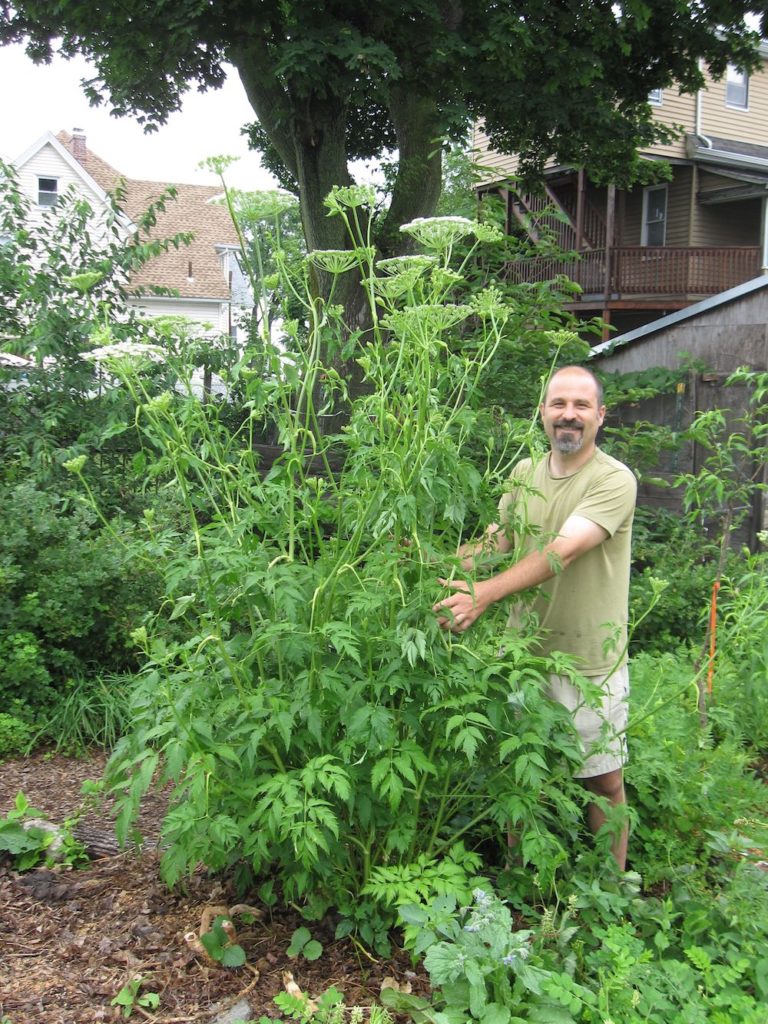In my world, plants that are both perennial, edible, ornamental and popular with pollinating insects are the most valuable (I term this class of plants edi-ento-mentals) and the Giant Ulleung Celery, Dystaenia takesimana, ticks all 3 boxes! That it can provide winter greens at a time of year when little else is available is its biggest advantage as an edible plant! This plant has been a closely guarded secret amongst a selected few for many years, but is now poised for the big(ger) time! The fact that I’ve written the article below about this plant is thanks to one man, plant breeder Professor Elwyn Meader (1910-1996) who collected seed on its small home island of Ulleung-do in the East Sea between the Korean peninsular and Japan in 1953! Without his generosity and enthusiasm 30 or so years ago to share seeds, we wouldn’t know about one of the potentially most useful permaculture plants! Please download the article below and seek out plants and seed!
The photo below of a flowering Giant Ulleung Celery at Eric Toensmeier’s home Paradise Lot in Holyoke, Massachusetts is courtesy of Jonathan Bates, who’s in the picture too.


Since korean celery looks clumpy (rather like sunchoke, which I grow in a 100L pot), I wonder, can korean celery be grown in a large say, 50L or 100L pot, do you think? I’m hoping to get some small plants soon. It’s a consideration partly due to clay soil (albeit fairly well draining) and partly for the sake of my poor back; any digging will cause pain!
Yes, it can!
Thanks so much, S. So glad to know!
My DT seedlings have grown so much since I last commented. They are amazingly fast growers! And also quite beautiful . I have 3 in a row. However, I tasted the young leaves today and wonder what I did wrong. They tasted terrible! Dull & bitter. Nothing like the usual bittersweet celery. And not at all like our delicious Hablitzia which tasted wonderfully like spinach (minus conventional spinach’s metallic aftertaste). What does your DT taste like?
I’ve only eaten it in winter when it’s only mildly bitter and not detectable when cooked. It comes to its forefront in winter as there is little else available at that time! I have heard others complain about an unpleasant bitterness though…
Ok, good tip. Maybe it needs a frost, first. Thanks, Stephen. By the way, you didn’t eat as salad; you cooked it. In (potato) soup or fry with oil and garlic? Thanks very much for your replies. Much appreciated; I just want to learn.
See my article about it – it can be downloaded here: https://www.edimentals.com/blog/?p=24998
When wild harvested it is soaked and parboiled or fermented (perhaps to reduce bitterness).
You can also read the accounts of folk who have tried it – some sensing bitterness, others not, but winter harvest seems to be the basis!
Must update you, S, that you are right after all. Soembadi tasted terrible in summer, so, I left it alone to grow for its beauty.
However, we had an early frost last month. And today I suddenly remembered you saying that you eat soembadi in winter! So I have just tasted a young leaf. And it tastes good!
It has a mildly bitter, herbal, refreshing parsley like taste. Will be perfect for sprinkling on pasta.
Now we don’t eat much pasta but I’m so happy to be growing them, as they seem to attract ladybirds.
And they are beautiful specimens. You can add them to large flowers in a vase for an exotic effect.
Excellent :)
Yes, very popular with the pollinators in summer!
I grew my Korean celery for years before I tried it – it’s a lovely plant. I now regularly use it for cooking, in place of celery. I finely shred the young leaves and stems and shallow fry with onion before adding stock – never noticed any bitterness but I tend to cook it in with a mixture of things. We don’t get a lot of frost here in the South West of UK.